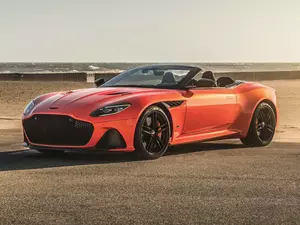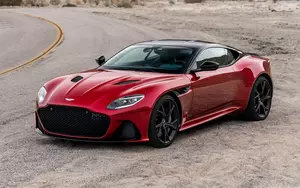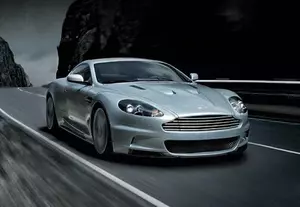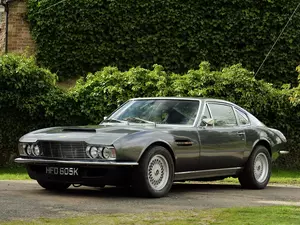
| Vehicle | Curb weight | Difference from world's smallest | Weight to power ratio | 0—60 mph acceleration ratio | Consumption ratio |
|---|---|---|---|---|---|
| 5.2 V12 |
1863 kg / 4108 lbs |
1438 kg (3171 lbs) heavier | 3 kg to 1 hp | 548 kg/s (1208 lbs/s) |
133 kg/L (293 lbs/L) |
| Vehicle | 5.2 V12 |
|---|---|
| Curb weight |
1863 kg / 4108 lbs |
| Difference from world's smallest | 1438 kg (1438 lbs) heavier |
| Weight to power ratio | 3 kg to 1 hp |
| 0—60 mph acceleration ratio | 548 kg/s (1208 lbs/s) |
| Consumption ratio |
133 kg/L (293 lbs/L) |

| Vehicle | Curb weight | Difference from world's smallest | Weight to power ratio | 0—60 mph acceleration ratio | Consumption ratio |
|---|---|---|---|---|---|
| 5.2 V12 |
1693 kg / 3733 lbs |
1268 kg (2796 lbs) heavier | 2 kg to 1 hp | 529 kg/s (1166 lbs/s) |
137 kg/L (302 lbs/L) |
| Vehicle | 5.2 V12 |
|---|---|
| Curb weight |
1693 kg / 3733 lbs |
| Difference from world's smallest | 1268 kg (1268 lbs) heavier |
| Weight to power ratio | 2 kg to 1 hp |
| 0—60 mph acceleration ratio | 529 kg/s (1166 lbs/s) |
| Consumption ratio |
137 kg/L (302 lbs/L) |

| Vehicle | Curb weight | Difference from world's smallest | Weight to power ratio | 0—60 mph acceleration ratio | Consumption ratio |
|---|---|---|---|---|---|
| 5.9 |
1710 kg / 3771 lbs |
1285 kg (2834 lbs) heavier | 3 kg to 1 hp | 417 kg/s (919 lbs/s) | - |
| Vehicle | 5.9 |
|---|---|
| Curb weight |
1710 kg / 3771 lbs |
| Difference from world's smallest | 1285 kg (1285 lbs) heavier |
| Weight to power ratio | 3 kg to 1 hp |
| 0—60 mph acceleration ratio | 417 kg/s (919 lbs/s) |
| Consumption ratio | - |

| Vehicle | Curb weight | Difference from world's smallest | Weight to power ratio | 0—60 mph acceleration ratio | Consumption ratio |
|---|---|---|---|---|---|
| 5.9 V12 |
1695 kg / 3737 lbs |
1270 kg (2800 lbs) heavier | 3 kg to 1 hp | 413 kg/s (911 lbs/s) |
103 kg/L (227 lbs/L) |
| Vehicle | 5.9 V12 |
|---|---|
| Curb weight |
1695 kg / 3737 lbs |
| Difference from world's smallest | 1270 kg (1270 lbs) heavier |
| Weight to power ratio | 3 kg to 1 hp |
| 0—60 mph acceleration ratio | 413 kg/s (911 lbs/s) |
| Consumption ratio |
103 kg/L (227 lbs/L) |

| Vehicle | Curb weight | Difference from world's smallest | Weight to power ratio | 0—60 mph acceleration ratio | Consumption ratio |
|---|---|---|---|---|---|
| 5.3 V8 |
1727 kg / 3808 lbs |
1302 kg (2871 lbs) heavier | 6 kg to 1 hp | - | - |
| Vehicle | 5.3 V8 |
|---|---|
| Curb weight |
1727 kg / 3808 lbs |
| Difference from world's smallest | 1302 kg (1302 lbs) heavier |
| Weight to power ratio | 6 kg to 1 hp |
| 0—60 mph acceleration ratio | - |
| Consumption ratio | - |

| Vehicle | Curb weight | Difference from world's smallest | Weight to power ratio | 0—60 mph acceleration ratio | Consumption ratio |
|---|---|---|---|---|---|
| 4.0 |
1588 kg / 3502 lbs |
1163 kg (2565 lbs) heavier | 6 kg to 1 hp | - | - |
| Vehicle | 4.0 |
|---|---|
| Curb weight |
1588 kg / 3502 lbs |
| Difference from world's smallest | 1163 kg (1163 lbs) heavier |
| Weight to power ratio | 6 kg to 1 hp |
| 0—60 mph acceleration ratio | - |
| Consumption ratio | - |